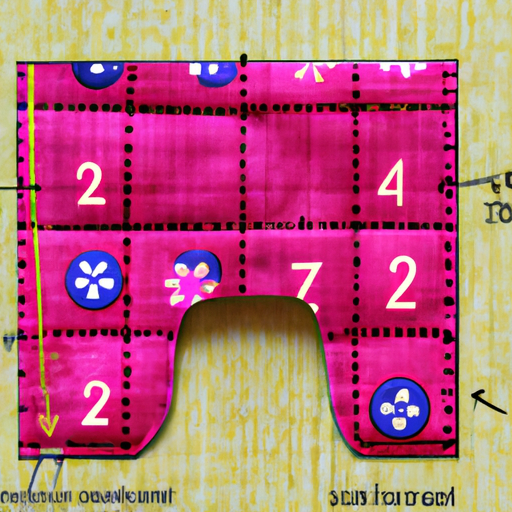
What stitch length for walking foot quilting?
As a lover of all things quilting, I understand the joy that comes from transforming squares of fabric into a work of art. But now, picture this: you’ve picked your fabric, pieced your quilt top, and even picked out your batting and backing. You’ve put in countless hours of hard work and creativity, pouring your heart and soul into every stitch. But then the question hits you like a ton of bricks: what stitch length should I use for walking foot quilting? You’re not alone in this anxiety-inducing dilemma. In fact, it’s a question that plagues even the most experienced quilters. So, let’s dive into the world of stitch length and walk together on this journey towards the perfect walking foot quilting stitches.
1. Discover the Magic: Walking Foot Quilting
Walking foot quilting is a fascinating technique that involves using a special foot on your sewing machine to move fabric layers smoothly and evenly through the machine. With this method, you don’t need to have advanced skills to create stunning quilting designs. It is all about discovering the magic in your creativity.
The walking foot is a game-changer for quilters. It moves the fabric back and forth, preventing it from bunching up or slipping while you’re stitching, ensuring perfect results every time. And that’s not all; it also opens up limitless possibilities for creating unique patterns with ease. You can create stunning texture and designs by simply stitching in the ditch, echoing shapes, or using spirals.
One of the most marvelous things about walking foot quilting is that it provides an excellent opportunity for the imagination to run wild. You can let your creativity flow effortlessly and come up with something extraordinary with hardly any effort. You can make patterns that match the fabric design, and it is easy to do with a walking foot. You can also experiment with different stitches to make your quilts a true work of art.
Another significant aspect of walking foot quilting is its versatility. It can work on any fabric, be it thick or thin, whether you’re working with cotton, wool, or fleece. Plus, you can experiment with different thread colors to add more depth and texture to your creations.
In conclusion, walking foot quilting is a fantastic method for new quilters and seasoned ones alike. It provides easy and limitless possibilities to create stunning and unique designs even with minimal experience. The only limit is your imagination. So why not discover the magic of walking foot quilting today?
2. The Secret to Perfect Quilting: Stitch Length
When it comes to quilting, one of the most important factors to consider is stitch length. The perfect stitch length could make or break the beauty of the quilt. To achieve perfect quilting, you must master the art of selecting the right stitch length for each section of the quilt.
Selecting the right stitch length depends on a variety of factors, including the type of material being used, the size of the quilt, and the specific design of the quilt. Generally, it’s advisable to use shorter stitch length for intricate designs as it will create a more precise finish. Long stitches, on the other hand, are perfect for larger designs and can add elegance to a simple pattern.
Be sure to test the stitch length on a sample piece of fabric to get a feel for how it will look on the finished product. It’s better to make mistakes on a test piece than on the actual quilt. Don’t be afraid to experiment with different stitch lengths and try out various designs until you find the perfect combination.
Remember: quilting is more than a hobby; it’s a way of breathing life into art. It’s an expression of creativity and passion, and the stitch length you choose can make all the difference. With practice and tenacity, you can master the art of perfect quilting, ensuring that every stitch you make adds beauty and elegance to your masterpiece. So, choose wisely!
3. The Emotional Connection between Stitch Length and Quality Quilting
Stitch length may seem like a technical aspect of quilting, but it can actually have a profound emotional impact on the final product. Here are a few ways in which stitch length can influence the quality of your quilting and the emotional connection you have with your finished piece.
1. Stitch length affects texture: A shorter stitch length results in tighter, more densely packed stitches, which can create a smoother, denser overall texture. A longer stitch length produces more visible stitching, which can create a looser, more open texture. Consider the emotional impact you want your quilt to have when choosing your stitch length – a dense texture can create a feeling of warmth and snugness, while an open texture can feel airy and light.
2. Stitch length can reveal imperfections: Perfectly even stitching is a hallmark of high-quality quilting. Stitching that is too long or too short can reveal small imperfections in your piecing or quilting skills. While this can feel frustrating, remember that imperfections are what make handmade quilts unique and special. Rather than striving for absolute perfection, focus on creating a piece that expresses your unique style and personality.
3. Stitch length requires attention: Quilting can be a meditative and relaxing activity, but don’t let that lull you into complacency when it comes to stitch length. Consistently monitoring and adjusting your stitch length as you work ensures that your final product will be of the highest quality. It can be easy to become emotionally invested in a quilt and to place pressure on yourself to create something flawless, but remember that the true beauty of quilting lies in the process of creation itself.
In short, is complex and multi-layered. Ultimately, the most important factor is to approach your quilting with intention and attention to detail, and to let your own unique style and personality shine through in your final product. The end result will be a quilt that is as emotionally rich as it is technically sound.
4. The Science behind Stitch Length for Walking Foot Quilting
Understanding can elevate your sewing skills and produce better results. The walking foot is an essential tool for quilters because it feeds multiple layers of fabric evenly, creating a precise and even stitch. Combined with the right stitch length, it enhances the final texture and strength of your quilt.
When working with a walking foot, a stitch length between 2.5 to 3.5mm is ideal. This length allows the fabric layers to move smoothly under the foot while ensuring that the stitch is neither too tight nor too loose. The stitches should be visible but not too obtrusive, so that they blend in with the overall design.
Moreover, the stitch length also affects the amount of thread used in the quilting process. A shorter stitch length produces more stitches per inch, resulting in more thread used, while a longer stitch length uses less thread. Therefore, finding the right balance between stitch length and thread usage is key to achieving perfect quilting results.
Ultimately, is about finding the optimal balance between precision and aesthetics. With the right stitch length, you can create a finished quilt that is both visually pleasing and functional. So, take the time to experiment with different stitch lengths and see the magic unfold!
5. Finding the Ideal Stitch Length for Your Walking Foot Quilting Journey
One of the most important factors when it comes to walking foot quilting is finding the ideal stitch length. The stitch length you choose will determine the overall look and feel of your quilt, so it’s essential to get it just right.
To start, it’s important to consider the type of quilting project you’re working on. For example, if you’re creating a densely quilted project, you’ll want to use a shorter stitch length, as this will create a dense, compact look. On the other hand, if you’re working on a project that’s meant to be more free-flowing, a longer stitch length will give a looser, more relaxed effect.
Another factor to consider when choosing the ideal stitch length for your walking foot quilting journey is the type of fabric you’re using. Thicker and heavier fabrics typically require a longer stitch length to avoid puckering, while thinner fabrics will benefit from a shorter stitch length.
Ultimately, finding the perfect stitch length is a matter of trial and error. It’s important to experiment with different stitch lengths and types of fabric until you find the combination that works best for your project. Don’t be afraid to play around with different lengths until you find the sweet spot – it’s all part of the creative process.
In summary, choosing the ideal stitch length for your walking foot quilting journey is a crucial step in creating a beautiful and functional quilt. By considering the type of project and fabric you’re working with, and experimenting with different stitch lengths, you’ll be well on your way to crafting a masterpiece that you can be proud of for years to come.
6. From Frustration to Joy: Mastering Stitch Length in Walking Foot Quilting
Are you tired of feeling frustrated every time you sit down at your quilting machine? Do you struggle to maintain a consistent stitch length and end up with wonky, uneven stitches? Fear not, for there is hope!
Mastering stitch length in walking foot quilting may seem like an impossible feat, but with a few tips and tricks, you can transform your quilting experience from one of frustration to pure joy.
First, make sure your machine is properly set up for walking foot quilting. Check that your foot is securely attached and that your quilt is basted or pinned in place. An unstable quilt can easily throw off your stitch length and cause frustration.
Next, practice, practice, practice! Start by quilting straight lines and focus on consistently moving your fabric at a steady pace. Slow and steady wins the race in walking foot quilting, and rushing will only lead to frustration and uneven stitches.
Another helpful tip is to use a guide to help maintain even spacing between your lines of stitching. This can be as simple as drawing lines on your fabric with a water-soluble pen or using a specialized quilting ruler or template.
Finally, don’t be too hard on yourself. Remember that quilting is a learning process and mistakes happen. Celebrate the small victories along the way and don’t let frustration get the best of you. With time and practice, you too can master stitch length in walking foot quilting and experience the pure joy that comes with creating a beautifully quilted masterpiece. As you embark on your next quilting project, remember the importance of stitch length when working with a walking foot. The right stitch length can make all the difference in the finished product, creating a beautiful and lasting work of art that you can be proud of.
So take the time to experiment and find the perfect stitch length that works for you. Let your creativity lead the way as you explore the different possibilities and discover new techniques. And above all, enjoy the process.
After all, quilting is not just a hobby, it’s a labor of love. It’s a way to express yourself, to connect with others, and to create something that will be cherished for generations to come.
So go ahead, quilt away with your walking foot and your chosen stitch length, and let your heart guide your hand. The end result will be a masterpiece that will bring joy and beauty to your life, and the lives of those around you.